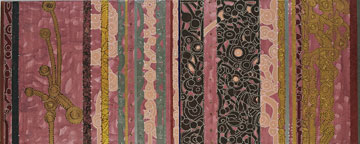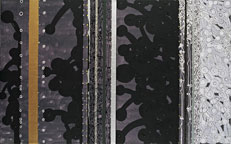Amitava:
Days and seasons of the self
By Swapna Vora
July 10, 2007
Hemant and Shishir are short fleeting periods in tropical India, when the seasons shift into winter. They have to be observed, perhaps, only as they pass on. The pale pinks and rich autumn colors of Amitava’s Hemant (fig. 1) are a visual delight and he charmingly explains his involvement with the seasons. The panels of color, the panes of filigreed drawings, the dreamtime white dots are reminiscent of Australia’s original inhabitants and the foreheads of Hindu brides.
Ratri is a truly lovely painting with panels of deep blues, sharp spiky stars and a moon. Against the painstakingly done, elaborate and rather gorgeous details, Amitava turns to drawing, the primal skill, and adds complicated labyrinths of lace. How wonderful when an artist does his beautiful, moving work and then even explains some of the emotions and thought that went into it!
Neelambari shows the heavy blues of a tropical sky and then along comes Shiva as the Kundalini shakti glides in, in the form of a guileless snake. One remembers Bhujagendra haram, a garland of snakes for Shiva. This painting is done in copper and metallic paint.
A painting may tell a story or be an abstract gateway or a door clanged shut, a key or a padlock. Strong in his ability to evoke a story or simply a thought, a feeling or just visual, visceral delight or devastation, Amitava spoke of Australian art, of dreamtime. Dreamtime is a soft, sharp, alpha state when one sees into the heart of things and remembers all that has happened or perhaps will happen. Dreamtime leads into Akashic records, where there are no lapses of memory, no tricks of judgment. Amitava’s paintings often show the white dots from a Hindu bride’s face or perhaps from Australian dreamtime or Warli aboriginal work. His work is both abstract and a narrative, sometimes deeply thought strokes of paint, sometimes a story leading from one panel to another like the Rajput miniature paintings which show multiple views and perspectives or time lapse stories simultaneously. Amitava elaborates: “I do not condition the viewer, he should follow his own feelings and be free to see it his way, in any fashion. Every successful work reflects the artist or else it simply remains graphic. Years of practice and sadhana with contemplation bring this about. (Sadhana is one’s spiritual work in the world, and a means to avoid complacency.) I always separated class work and my personal work. There was work I had to produce for art school and there was my private work, done for me because I had to. I was offered a gallery as a student and could then exhibit my world and my work early. I designed exhibitions for Indian pavilions and overseas exhibitions for 25 years and my bonus was travel to different countries. If I had to do the same again, I would do it because the travel and the opportunity to visit with other artists and their commentaries were precious. However I have currently moved away from installations. My roots are Indian but I revel in a world view, seeing the universe as mine to enjoy, to traverse.” And to depict with thoughtful delight!
Amitava’s work is a reflection of a time, immediately after independence, when Indian artists felt themselves a part of the world and were at home in the cosmos. However the world did not see them as itself. That has not yet happened, because often Indian art is seen by an unconscious western world as rooted only in India: pleasant, maybe lovely, but a part of a somewhat remote, incomprehensible Indian experience. We are now seeing a crack in the cosmic egg and a chance for Indian artists to dwell in the psyche, not just of ancient or contemporary Hindustan, but in the western and the far eastern hemispheres of planet earth’s brain.
One of Amitava’s paintings is involved with the seasons and musical raags. You see sunshine and sundown. You can reflect on twilight, a magical rare moment in tropical countries because it vanishes so quickly and is often nonexistent. He enjoys Godhuli, when the cows return home from the fields and as they walk, the raised dust obscures the world. His work shows this gentle, soft time with its dusty, dusky details, without the harshness of the high noon sun. He reiterates, “My roots were Indian but increasingly, my view included the world. When invited to design pavilions for Indian trade fairs, my general interest was to see the world, especially design and architectural things. I had to design the whole pavilion, the entire structure, including the costumes, and not just a bit of the decorative element. I do not feel like using installations anymore for I want to work with paint and canvas. I want to use pen and ink, and go back to drawing. This is easiest, in a sense, materially, for I can do it anywhere. It is intimate, not sterile. I was exposed to aboriginal work in Delhi and in Australia. I enjoy Warli work and love Basholi, which I see as very contemporary in nature and very vibrant, universal and valid. I am most aware of travel and new things. A big exhibition of French art in Delhi, enabled me to breathe near the canvases of Picasso and Braque. I remember Guernica and think of Abu Ghraib. I am influenced by Verlaine’s words, Rimbaud’s feelings, and have felt their silences. The autumn elements have come together in my paintings now, and I depict each season, each element. I enjoyed the explorations of Rauschenberg, Jasper Johns and Tapiere. Tapiere in particular influenced me, influenced so much.” Currently the New York subway shows a weak translation of Verlaine’s sobbing violins of autumn and perhaps Amitava was thinking of this particular poem. Mentioning contemporary architects, like Zaha Hadid, brought a smile of delight to Amitava’s face.

